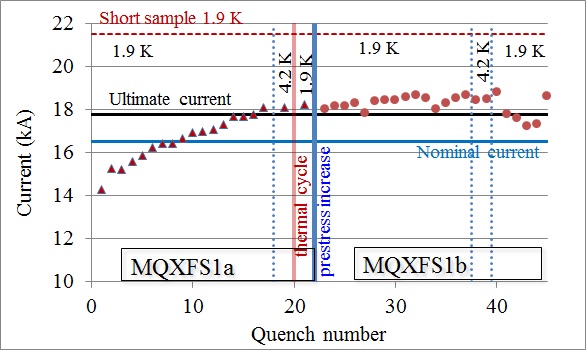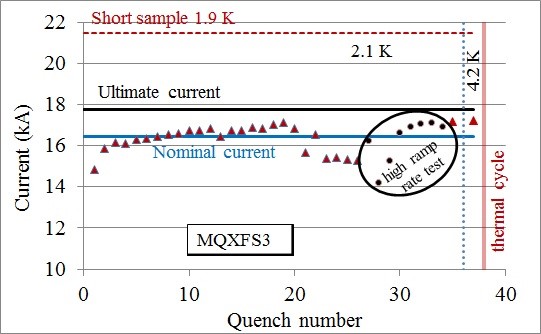 Triplet magnets program progressing on both sides of the Atlantic
Triplet magnets program progressing on both sides of the Atlantic
by G. Ambrosio, P. Ferracin, E. Todesco (CERN)
The Nb3Sn 150 mm aperture quadrupoles MQXF, to be installed in the inner triplets around ATLAS and CMS in 2024-5, are entering a critical phase; the first two 1.5-m-long models have been manufactured and tested since the beginning of this year.
This magnet development program, carried out as a joint effort between CERN and US LARP foresees the construction and testing of five 1.5-m-long models to validate the design and fine tune the assembly features during 2014-17.
These magnets rely on the Al shell and bladder&key structure, allowing easy and fast disassembly, and a precise tuning of the coil prestress. Mechanics is a critical part in the design of these large aperture quadrupoles, featuring an 11.4 T peak field in the coils (50% larger than the peak field in the LHC dipoles operating at 6.5 TeV).
The first model, MQXFS1, was assembled in the U.S. with two CERN coils and two LARP coils, and was confirmed to fulfil performance requirements in April 2016 (see Figure 1). The performance requirements included a) reaching the ultimate current (8% higher than the nominal current of 16.4 kA), and b) reaching nominal current after a thermal cycle with at most one quench.

Figure 1: Training of MQXFS1: quenches (markers), nominal and ultime current (solid lines) and short sample limit (dotted line). (Credit: HL-LHC WP3 collaboration)
The memory after thermal cycle has outperformed expectations by exceeding ultimate current in the first quench after the thermal cycle. However, training has been slower than expected, reaching nominal current after nine quenches. After this first cycle of testing, the transverse pre-stress in the magnet was increased by 30%, to ensure a better support to the coils.
In October 2016, the second assembly was tested at FNAL, reaching 18.8 kA; which is 15% more than the nominal current, and close to 90% of the maximum theoretical performance of the magnet. Some detraining has been observed sporadically, reducing the magnet performance but keeping it always well above the nominal current.
At 4.2 K the magnets shows the ability to reach the same current, thus demonstrating the existence of a considerable margin in temperature, meaning the magnet should tolerate local heating).
The second model, MQXFS3, (MQXFS2 has been postponed to 2017) has been tested at CERN in October 2016, using a novel test station (HFM) planned to be used for the Fresca II dipole.
The magnet reached nominal current with nine quenches, as MQXFS1, but reached a current only 4% above nominal after 20 quenches. A significantly larger detraining than in MQXFS1 was observed, pushing the magnet performance well below nominal (15.0 kA).
Nonetheless, the maximal performance of 17.2 kA has been recovered after ramp rate tests. In addition, 4.2 K test, shows the same performance reached at 2.1 K and also demonstrates the existence of a considerable temperature margin.

Training of MQXFS3: quenches (markers), nominal and ultimate current (solid lines) and short sample limit (dotted line). (Credit: HL-LHC WP3 collaboration)
Work is now focussed on understanding the relationship between the quenches and the mechanical structure. As quenches are mainly located in the coil heads the longitudinal preload will be increased. Further testing after the thermal cycle is expected for the end of the year and . three additional models are foreseen in 2017.
The program will run in parallel with the development of the long coils (4.2 m in US and 7.15 m in CERN) required for the full size magnets.
“The short model program is a fundamental tool to master the design and construction of superconducting magnets, and it is even more important for a novel technology as Nb3Sn” says L. Bottura, leader of the CERN Magnet, Superconductors and Cryostat group. “If needed, we will prolong the short model program to improve our understanding and to reduce the risks in the construction of the prototypes and of the series.”